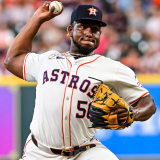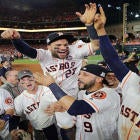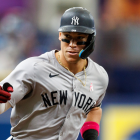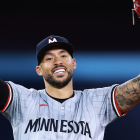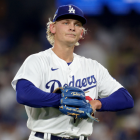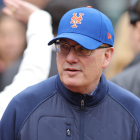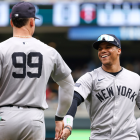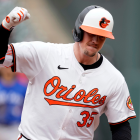Baseball is, and always has been a copycat sport. When Babe Ruth sent the Dead Ball Era crashing down with a barrage of titanic homers for the Yankees, other teams chased sluggers to call their own. When Jackie Robinson smashed the color barrier and became a star for the Dodgers, other teams started mining the Negro Leagues for talent, having been spared the responsibility of being the first to take a stand against Major League Baseball's segregationist ways.
Welcome to baseball's latest copycat scheme: How to tank your way to glory.
The Cubs and Astros are the new poster teams for that approach. Both stripped their major league roster to the bone, acquiring the young talent and financial flexibility they'd need to start their climb back to contention. Both executed their plans so perfectly -- and nabbed enough luck along the way -- to break unfathomably long World Series droughts.
Watching those teams jumping around like 10-year-olds after the final out of the Fall Classic stokes the fire for the ballclubs that are now in the thick of major rebuilding jobs. Some of those rebuilding teams are now taking that motivation to the next level, spending (or threatening to spend) gigantic sums of money on veteran players, even when they appear to be years away from even having a shot to replicate what Chicago and Houston have done.
The Phillies and Padres lost 96 and 91 games respectively in 2017. Now, both clubs seem eager to dig deep into their war chest to acquire brand-name players. The question is, does that approach make any sense?
For the Phillies, this isn't a hypothetical scenario. On Dec. 15, they dealt veteran shortstop Freddy Galvis to San Diego for minor league pitcher Enyel De Los Santos. That meant the team's highest salary commitment for 2018 was Odubel Herrera, the talented and bargain-priced outfielder who'll make just $3.35 million next season. In fact some of Philly's best players, including staff ace Aaron Nola and rookie sensation Rhys Hoskins, will make about the league minimum in 2018. This looked like a team that was bottoming out, ready to build around its young talent, with the hope of adding key veteran pieces a year or two down the road, as that young core started to mature.
Turns out that wasn't the plan at all. On the same day the Phillies shipped Galvis out of town, they also ponied up for two veteran, high-priced relievers. Two-time All-Star Pat Neshek and hard-throwing righty Tommy Hunter instantly became the team's two highest-paid players (by far), and will make a combined $16.75 million in the coming season.
The coup de grace came five days later. Despite seemingly having their answer at first base for the next six years, and being years away from challenging the National League's elite, the Phils took the plunge on veteran slugger Carlos Santana. The cost? A smooth three years, $60 million. Man, that was a hot one. Like, seven inches from the midday sun.
Heading into this winter, the Padres looked even thriftier, and further away from contention, than the last-place Phillies. San Diego rolled out baseball's third-lowest Opening Day payroll last year. The club's only players signed beyond 2018 were low-priced lefty Clayton Richard, and Wil Myers, who's owed just $10 million combined in the next two seasons before his salary balloons to $22.5 million in 2020. Like the Phillies, the Padres owned a well-regarded farm system, but unlike the Phillies, San Diego's best prospects were (and are) likely years away from challenging for big league gigs.
Then, the spending started. First, the Padres did the Yankees a colossal favor, taking Chase Headley's $13 million 2018 salary off New York's ledger in a puzzling three-player deal. A pair of low-cost, two-year deals for relief help followed. Now, the Padres are reportedly going hard after Eric Hosmer, potentially dangling as much as $140 million on a seven-year megadeal.

For the Phillies, the moves for Santana, Neshek, and Hunter represent an aggressive and optimistic read of the landscape. There's some logic behind the moves, though.
Consider how well some loaded-bullpen teams with significant roster flaws have fared in recent years. Most famously, the Royals overcame iffy starting pitching and a lack of power to win two straight American League pennants and a World Series, thanks in large part to a three-headed beast of a pen. Neshek and Hunter were two of the best relievers in the league last year, and their presence could help both shorten games and deliver more wins in close contests, both of which would be highly welcome developments for a ballclub with a young starting rotation.
Also, the Phillies might be closer to contending than you might think just by glancing at their horrific 2017 record. They play in a division with only one top-notch team in it, the Nationals. Washington aside, you've got the Braves (a team with a great farm system that's still light on major league talent), the Mets (great young pitching, but also tons of question marks), and the Marlins (hoo boy). Given that most of Philly's best young players have already arrived in the majors, things could turn for the better in a hurry, and stay that way for a while. Think on this: Nola, Hoskins, J.P. Crawford, Jorge Alfaro, Nick Williams, and Herrera are all 26 or younger, and Santana is the only member of the projected lineup older than 27.
The Padres have a tougher road to navigate. Their stable of major league-ready young position players lags well behind Philly's. Still, you could try to play devil's advocate a bit, with the devil in this case being indefatigable general manager A.J. Preller. Hunter Renfroe and Manuel Margot are raw but skilled outfielders who could fare better in their second full big league seasons. Young right-handers Dinelson Lamet and Luis Perdomo did show off some potential last season, offering more hope.
Still, the play for Hosmer looks different than Philly scooping up Santana, for two reasons. First, Hosmer is just 28 years old, offering hope that he could have multiple prime years in front of him ... even if his power isn't all that impressive for a first baseman, and advanced defensive metrics don't deem him worthy of the four Gold Gloves he's won. Second, it's the Padres. How many recognizable stars have the Pads had since Tony Gwynn retired? Hell, how many franchises have gone a half-century with this little success, toiling in this much anonymity? A better-than-average first baseman who's a notch below the game's best probably isn't selling many tickets on his own. But the Padres have money to spend, a bone that needs throwing at their long-suffering fans, and the faint hope that Hosmer's middling power might somehow blossom in the place where left-handed power hitters go to die.
We've seen other rebuilding teams suddenly spend big money before the masses would've expected, of course -- starting with those blueprint-setting 2016 Cubs. Following the 2014 season, the North Siders made a huge splash in free agency, reeling in lefty ace Jon Lester on a $155 million deal. The calculus was a little different in that case, with the Cubs winning a slightly more respectable 73 games that year, their second straight season of improvement after bottoming out at 61-101 in 2012. Also, the Cubs didn't stop there, acquiring Dexter Fowler, Miguel Montero, and Jason Hammel that winter, while also hiring Joe Maddon to manage the team. If you're going to try to goose your rebuilding process, it's probably best to really go for it rather than make an isolated deal or two.
Go back through the years and you'll find a mixed bag of results when it comes to rebuilding clubs hoping to find their own version of Lester. Two years earlier, the Cubs fired $52 million at Edwin Jackson, a move that failed spectacularly both for its premature signing, and simply getting the wrong guy to help. The future-champion Astros lost 111 games in 2013, then tried to rid themselves of humiliation and 0.0 local TV ratings by signing multiple veterans, including Scott Feldman on a three-year, $30 million. Again, too little, too early.
Elsewhere, the Royals lost 100 games in 2006, then decided that waving $55 million at Gil Meche would somehow solve their problems (it did not). On the plus side, the Nationals took a beating for inking Jayson Werth to a $126 million deal fresh off a 69-93 campaign. Injuries and age would in fact make that deal a bust, though Werth did at least bank two top-20 MVP finishes in 2013 and 2014 as the Nats improved into a perennial contender. And if you want two words that perfectly encapsulate the risks involved when a lousy team throws a bunch of cash at a veteran free agent, I have two words for you: Operation Shutdown.
The most extreme recent case of spending at rock bottom might be the post-2003 Tigers. Detroit fielded one of the worst teams in baseball history in '03, losing an incomprehensible 119 games. How bad was that club? The staff leader in innings pitched and ERA was Nate Cornejo. Bonus points if you have any idea who Nate Cornejo was, or can read his stat line of 194 2/3 innings, 236 hits, 58 walks, and 46 strikeouts and not become gravely ill.
Thing is, the Tigers' GM in those days was Dealin' Dave Dombrowski, one of the most aggressive and least subtle baseball operators of all time. Rather than follow the old playbook of obsessing over prospects and waiting years to do anything interesting, Dombrowski immediately swung for the fences, luring future Hall of Fame Ivan Rodriguez from the defending World Series-champion Marlins to the team that just missed tying the post-1900 record for most losses in a season. That shocker of a move paved the way for a passel of other multi-year deals, with veteran outfielders Magglio Ordonez and Rondell White, lefty ace Kenny Rogers, and others joining via free agency. Add in a shrewd trade for slugging infielder Carlos Guillen and the development of top prospects like Justin Verlander and Curtis Granderson, and the Tigers stormed their way from near-record futility to the World Series in a span of just three years.
So say your prayers, Phillies and Padres fans. By winter's end, you could end up with a galvanizer like Pudge who guides your way to postseason glory, or the next Edwin Jackson. No pressure.








